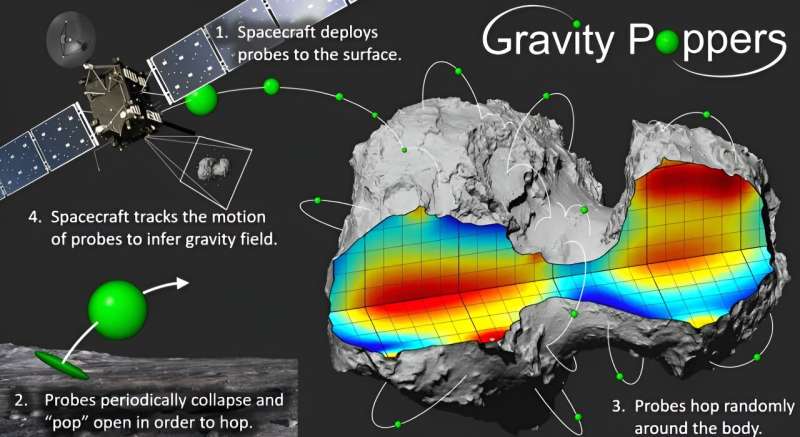This article has been reviewed according to Science X's editorial process and policies. Editors have highlighted the following attributes while ensuring the content's credibility:
fact-checked
preprint
trusted source
proofread
Miniaturized jumping robots could study an asteroid's gravity

Missions focusing on small bodies in the solar system have been coming thick and fast lately. OSIRIS-Rex, Psyche, and Rosetta are all examples of projects that planned or did rendezvous with a small body in the solar system. But one of their biggest challenges is understanding the gravity of these bodies—which was especially evident when Philae, Rosetta's lander, had a hard time staying on the surface of its intended comet. A new idea from researchers at the University of Colorado Boulder and NASA's Jet Propulsion Laboratory could help solve that problem—by bouncing small probes around.
The concept, called Gravity Poppers, resulted from a NIAC grant back in 2020. The idea is simple enough—release a bunch of probes onto the surface of a small body and have them periodically jump off it. When they do so, keep track of them. If you know the force they jumped off with and can track them as they return to the surface, you can estimate the gravity of the area they're floating over more accurately than alternative techniques.
Scientists use three main alternative techniques to calculate the gravity of small bodies—radar tomography, seismic imaging, and gravimetry. Each has disadvantages that the Gravity Poppers can overcome.
Radar tomography uses reflections of radio signals to estimate what the gravity is like in a particular area. However, it's difficult to penetrate the deeper sections of a small body. Some materials don't reflect electromagnetic waves at all, making it impossible to characterize areas with these materials.
Seismic imaging is commonly used on Earth. By tracking the movement of seismic waves across the surface of a body, scientists can estimate the gravity of regions surrounding them. However, some small bodies, especially asteroids, are just piles of rubble with no internal coherent structure. Seismic waves don't do very well in such environments. Ryugu, the asteroid Hayabusa-2 visited, absorbed the seismic energy of an impact event such that the spacecraft couldn't even discern any changes in its surface features.
Gravimetry is the most straightforward of the three techniques and requires the least equipment onboard the spacecraft. How does the small body pull on the spacecraft orbiting it? As it passes over different regions, does the gravity increase or decrease? However, measuring gravity from far away isn't easy, as orbits tend to be relatively far away. So, the accuracy of this technique is relatively low.
Enter Gravity Poppers. An orbiter could release a few dozen of these—a paper detailing the idea posted to arXiv suggests 20. As they land on the surface of the asteroid, comet, or small moon, they occasionally use an internal force to jump off the surface, but not enough to break the hold of gravity. Depending on the intended area to be studied, they could do this at an angle or straight up.
As they fly off the surface, the orbiting mothership tracks them and calculates their trajectory, which can then be used to calculate the gravity of the region they are flying over. They then land, reset themselves, and do it repeatedly with the orbiter tracking them. The team studied two types of structures for the poppers: spherical and cubic. They settled on the cube, which also had embedded LEDs that create a light source the orbiter could track.
It's not as simple as tracking the light source, though—plenty of system dynamics go into calculating the trajectory angle, the force with which the popper jumped, and the landing location. The paper also details simulations of how such a mission would operate in practice, using modeling software developed at NASA.
Unfortunately, that means that there are no prototypes in the works for this as of yet. It did not receive NIAC Phase II funding as of yet either. But the idea is unique and simple enough that with a little bit of development effort, engineers might be able to master this novel way of prospecting some of the most economically and scientifically interesting worlds in our solar system.
More information: Jacopo Villa et al, Gravity Estimation at Small Bodies via Optical Tracking of Hopping Artificial Probes, arXiv (2022). DOI: 10.48550/arxiv.2202.06412
Journal information: arXiv
Provided by Universe Today





















